Dr. Markus Kautz
seit 2019: Fachbereichsleiter, Abt. Waldschutz - FVA, Freiburg
- Schwerpunkte: Borkenkäfer - Waldschutz & Klima - Modellierung
- Forschung sowie Monitoring und Beratung in Baden-Württemberg & Rheinland-Pfalz/Saarland
2017 - 2019: Wissenschaftlicher Mitarbeiter, Abt. Waldschutz - FVA, Freiburg
- Projekt "IpsPro" - Abschätzung des raum-zeitlich-dynamischen Befallsrisikos durch den Buchdrucker
- Simulation mit dem Buchdrucker-Phänologiemodell PHENIPS
2014 - 2017: postDoc, IMK/IFU - KIT, Garmisch-Partenkirchen
- Simulation mit dem dynamischen globalen Vegetationsmodell LPJ-GUESS
- Modellweiterentwicklung zur Integration biotischer Waldstörungen durch Insekten & Pathogene
2013: Wissenschaftlicher Mitarbeiter, Abt. Waldschutz - LWF Bayern, Freising
- Luftbildgestützte Erkennung und Analyse von insektenverursachten Kronenschäden
- Risikoanalyse für Borkenkäferschäden in Wirtschaftswäldern in unmittelbarer Nähe zum NLP Bayerischer Wald
2009 - 2013: Doktorand, Tierökologie - TU München, Freising
- Raum-zeitliche Ausbreitungsdynamik von Borkenkäfern in den NLPs Bayerischer Wald, Šumava und Berchtesgaden
- Entwicklung und Anwendung eines individuen-basierten Borkenkäfer-Ausbreitungsmodells (IPS)
2008: Wissenschaftlicher Mitarbeiter, Waldwachstum & Fortstliche Informatik - TU Dresden, Tharandt
- Satellitengestützte Erkennung von Blitzschlagstörungen in Mangrovenwäldern in Vietnam
- Simulation von Störungseffekten in Mangroven mit einem individuen-basierten Modell (KiWi)
2006 - 2007: Trainee, Deutscher Entwicklungsdienst, Bolivien
- Tropische Forst- und Agrofortstwirtschaft
1999 - 2006: Studium der Geographie (Dipl.), TU Dresden, Dresden / Tharandt
- Schwerpunkte Physische Geographie, Forstwissenschaften, Kartographie
peer-reviewed paper:
Warlo H, Delb H, Albrecht A, Kautz M (im Review) Biotic risks to important tree genera under climate change in Europe. Journal of Cultivated Plants
Hofmann S, Kautz M, Schebeck M (im Review) High plasticity in diapause responses benefits bark beetles in a changing climate. Ecological Entomology
Warlo H, Kautz M (im Review) How do global forest pests respond to increasing temperatures? – A meta-analysis. Oikos
Hofmann S, Schebeck M, Kautz M (2024) Diurnal temperature fluctuations improve predictions of developmental rates in the spruce bark beetle Ips typographus. Journal of Pest Science, im Druck.
Kautz M, Feurer J, Adler P (2024) Early detection of bark beetle (Ips typographus) infestations by remote sensing – A critical review of recent research. Forest Ecology and Management 556, 121595
Kautz M, Peter FJ, Harms L, Kammen S, Delb H (2023) Patterns, drivers and detectability of infestation symptoms following attacks by the European spruce bark beetle. Journal of Pest Science 96, 403-414
Wang S, Zhang Y, Ju W, Chen JM, Ciais P, Cescatti A, ..., Kautz M, et al. (2020) Recent global decline of CO2 fertilization effects on vegetation photosynthesis. Science 370, 1295-1300
O'Sullivan M, Smith WK, Sitch S, Friedlingstein P, Arora VK, Haverd V, ..., Kautz M, et al. (2020) Climate‐driven variability and trends in plant productivity over recent decades based on three global products. Global Biochemical Cycles 34, e2020GB006613
Pugh TAM, Rademacher T, Shafer SL, Steinkamp J, Barichivich J, Beckage B, ..., Kautz M, et al. (2020) Understanding the uncertainty in global forest carbon turnover. Biogeosciences 17, 3961-3989
Yang H, Ciais P, Santoro M, Huang Y, Li W, Wang Y, ..., Kautz M, et al. (2020) Comparison of forest above-ground biomass from dynamic global vegetation models with spatially explicit remotely sensed observation-based estimates. Global Change Biology 26, 3997-4012
Forzieri G, Miralles DG, Ciais P, Alkama R, Ryu Y, Duveiller G, ..., Kautz M, et al. (2020) Increased control of vegetation on global terrestrial energy fluxes. Nature Climate Change 10, 356-362
Kondo M, Patra PK, Sitch S, Friedlingstein P, Poulter B, Chevallier F, …, Kautz M, et al. (2020) State of the science in reconciling top‐down and bottom‐up approaches for terrestrial CO2 budget. Global Change Biology 26, 1068-1084
Huang J, Kautz M, Trowbridge AM, Hammerbacher A, Raffa KF, Adams HD, Goodsman DW, Xu C, Meddens AJH, Kandasamy D, Gershenzon J, Seidl R, Hartmann H (2020) Tree defence and bark beetles in a drying world: carbon partitioning, functioning and modelling. New Phytologist 225, 26-36
Petr M, Vacchiano G, Thom D, Mairota P, Kautz M, Goncalves LMS, Yousefpour R, Kaloudis S, Reyer CPO (2019) Inconsistent recognition of uncertainty in studies of climate change impacts on forests. Environmental Research Letters 14, 113003
Pugh TAM, Arneth A, Kautz M, Poulter B, Smith B (2019) Important role of forest disturbances in the global biomass turnover and carbon sinks. Nature Geoscience 12, 730-735
Chen W, Zhu D, Huang C, Ciais P, Yao Y, Friedlingstein P, ..., Kautz M, et al. (2019) Negative extreme events in gross primary productivity and their drivers in China during the past three decades. Agricultural and Forest Meteorology 275, 47-58
Buermann W, Forkel M, O’Sullivan M, Sitch SS, Friedlingstein P, Haverd V, ..., Kautz M, et al. (2018) Widespread seasonal compensation effects of spring warming on plant productivity in northern ecosystems. Nature 562, 110-115
Wu D, Ciais P, Viovy N, Knapp AK, Wilcox K, Bahn M, …, Kautz M, et al. (2018) Asymmetric responses of primary productivity to altered precipitation simulated by ecosystem models across three long-term grassland sites. Biogeosciences 15, 3421-3437
Forzieri G, Duveiller G, Georgievski G, Li W, Robertson E, Kautz M, Lawrence P, Garcia San Martin L, Anthoni P, Ciais P, Pongratz J, Sitch S, Wiltshire A, Arneth A, Cescatti A (2018) Evaluating the interplay between biophysical processes and leaf area changes in land surface models. Journal of Advances in Modeling Earth Systems 10, 1102-1126
Le Quéré C, Andrew RM, Friedlingstein P, Sitch S, Pongratz J, Manning AC, …, Kautz M, et al. (2018) Global Carbon Budget 2017. Earth System Science Data 10, 405-448
Kautz M, Anthoni P, Meddens AJH, Pugh TAM, Arneth A (2018) Simulating the recent impacts of multiple biotic disturbances on forest carbon cycling across the United States. Global Change Biology 24, 2079-2092
Hartmann H, Moura CF, Anderegg WRL, Ruehr NK, Salmon Y, Allen C, ..., Kautz M, et al. (2018) Research frontiers for improving our understanding of drought-induced tree and forest mortality. New Phytologist 218, 15-28
Seidl R, Thom D, Kautz M, Martin-Benito D, Peltoniemi M, Vacchiano G, et al. (2018) Forest disturbances under climate change. Nature Climate Change 7, 395-402
Kautz M, Meddens AJH, Hall RJ, Arneth A (2017) Biotic disturbances in Northern Hemisphere forests – a synthesis of recent data, uncertainties and implications for forest monitoring and modelling. Global Ecology and Biogeography 26, 533-552
Kautz M, Imron MA, Dworschak K, Schopf R (2016) Dispersal variability and associated population-level consequences in tree-killing bark beetles. Movement Ecology 4:9
Seidl R, Müller J, Hothorn T, Bässler C, Heurich M, Kautz M (2016) Small beetle, large-scale drivers: how regional and landscape factors affect outbreaks of the European spruce bark beetle. Journal of Applied Ecology 53, 530-540
Kautz M (2014) On correcting the time-lag bias in aerial-surveyed bark beetle infestation data. Forest Ecology and Management 326, 157-162
Kautz M, Imron MA, Schopf R (2014) Individual traits as drivers of spatial dispersal and infestation patterns in a host-bark beetle system. Ecological Modelling 273, 264-276
Hooman L, Schumann B, Kautz M, Dech S (2014) Spatial characterization of bark beetle infestations by a multidate synergy of SPOT and Landsat imagery. Environmental Monitoring and Assessment 186, 441-456
Vogt J, Kautz M, Fontalvo Herazo ML, Walther D, Diele K, Triet T, Saint-Paul U, Berger U (2013) Do canopy disturbances drive forest plantations into more natural conditions? – A case study from Can Gio Biosphere Reserve, Vietnam. Global Planet Change 110, 249-258
Kautz M, Schopf R, Ohser J (2013) The “sun-effect”: microclimatic alterations predispose forest edges to bark beetle infestations. European Journal of Forest Research 132, 453-465, erratum: 467
Kautz M, Düll J, Ohser J (2011) Spatial dependence of random sets and its application to dispersion of bark beetle infestation in a natural forest. Image Analysis & Stereology 30, 123-131
Kautz M, Dworschak K, Gruppe A, Schopf R (2011) Quantifying spatio-temporal dispersion of bark beetle infestations in epidemic and non-epidemic conditions. Forest Ecology and Management 262, 598-608
Kautz M, Berger U, Stoyan D, Vogt J, Khan NI, Diele K, Saint-Paul U, Triet T, Nam VN (2011) Desynchronizing effects of lightning strike disturbances on cyclic forest dynamics in mangrove plantations. Aquatic Botany 95, 173-181
Buchkapitel, Zeitschriftenartikel (Auswahl):
Kautz M, Delb H, Hielscher K, Hurling R, Lobinger G, Niesar M, Otto L-F, Thiel J (2023) Borkenkäfer an Nadelbäumen – erkennen, vorbeugen, bekämpfen. FNR (Hrsg.), Gülzow-Prüzen, 54 S.
Kautz M, Delb H (2023) Reduziert das Management von Kronenbrüchen Stehendbefall durch Borkenkäfer an Fichten? Forstschutz aktuell 68, 3-11
Seidl R, Kautz M (2022) Impacts of climate change on disturbances. S. 377-389, In: Disturbance ecology. Wohlgemuth T, Jentsch A, Seidl R (Hrsg.), Springer, 439 S.
Fettig CJ, Egan JM, Delb H, Hilszczanski J, Kautz M, Munson AS, Nowak JT, Negrón JF (2022) Management tactics to reduce bark beetle impacts in North America and Europe under altered forest and climatic conditions. S. 345-394, In: Bark beetle management, ecology, and climate change. Gandhi K, Hofstetter R (Hrsg.), Academic Press, 438 S.
Peter FJ, Harms L, Kautz M (2020) Modellierung von Borkenkäferphänologie und Befallsdruck. AFZ-Der Wald 18, 19-21
Seidl R, Kautz M (2019) Einfluss des Klimawandels auf Störungen. S. 325-336, In: Störungsökologie. Wohlgemuth T, Jentsch A, Seidl R (Hrsg.), Haupt-Verlag Bern, 396 S.
Seidl R, Kautz M, Heurich M, Müller J (2016) Borkenkäferdynamik am Beispiel Bayerischer Wald. AFZ-Der Wald 9, 36-38
Diurnal temperature fluctuations improve predictions of developmental rates in the spruce bark beetle Ips typographus. Journal of Pest Science.
Early detection of bark beetle (Ips typographus) infestations by remote sensing – A critical review of recent research. Forest Ecology and Management 556, 121595
Borkenkäfer und Rüssler profitieren von Trockenstress an Weißtannen

Die sich seit dem Spätsommer 2022 rot färbenden Weißtannen (Abies alba) machen es offen-sichtlich – der vergangene trocken-heiße Sommer hinterließ auch an dieser im Gegensatz zur Fichte als relativ Klimawandel-tolerant betrachteten Baumart wieder seine Spuren. Die klimageschwächten Weißtannen werden von biotischen Schadorganismen befallen, wie Borkenkäfern und Weißtannenrüsslern, welche letztlich den Baum zum Absterben bringen.
Borkenkäfer und Rüssler profitieren von Trockenstress an Weißtannen. Forstliche Versuchs- und Forschungsanstalt Baden-Württemberg, Waldschutz-Info 1/2023, 8 S.
Borkenkäfer und Waldmaikäfer bleiben ohne Gefahr – Waldschutzsituation 2022/2023 in Rheinland-Pfalz und Saarland. Landwirtschaftliches Wochenblatt. Hessenbauer, Pfälzer Bauer, Der Landbote. LW 22, 34-36
Die Waldschutzsituation 2022/2023 in Baden-Württemberg. AFZ/Der Wald 78 (9), S. 16-20
Die Waldschutzsituation 2022/2023 in Rheinland-Pfalz und Saarland. AFZ/Der Wald 78 (9), 25-28
Patterns, drivers and detectability of infestation symptoms following attacks by the European spruce bark beetle.https://link.springer.com/article/10.1007/s10340-022-01490-8
Reduziert das Management von Kronenbrüchen Stehendbefall durch Borkenkäfer an Fichten? Forstschutz aktuell 68, 3-11https://www.bfw.gv.at/wp-content/uploads/FS-Aktuell_1.pdf
Waldschutzsituation 2022/2023 in Rheinland-Pfalz und Saarland – Schäden an der Buche noch weit verbreitet. Rheinische Bauerzeitung (RBZ), Wochenblatt für das nördliche Rheinland-Pfalz und Saarland 22, 24-26
Borkenkäfer-Management nach Kronenbrüchen an Fichte
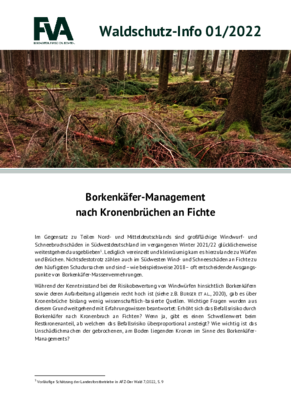
Im Gegensatz zu Teilen Nord- und Mitteldeutschlands sind großflächige Windwurf- und Schneebruchschäden in Südwestdeutschland im vergangenen Winter 2021/22 glücklicherweise ausgeblieben. Lediglich vereinzelt und kleinräumig kam es hierzulande zu Würfen und Brüchen. Nichtsdestotrotz zählen auch im Südwesten Wind- und Schneeschäden an Fichte zu den häufigsten Schadursachen und sind – wie beispielsweise 2018 – oft entscheidende Faktoren von Borkenkäfer-Massenvermehrungen.
Borkenkäfer-Management nach Kronenbrüchen an Fichte. Forstliche Versuchs- und Forschungsanstalt Baden-Württemberg, Waldschutz-Info 1/2022, 5 S.
Borkenkäfer-Newsletter SüdWest 1/2022: Was bringt uns das Käferjahr?
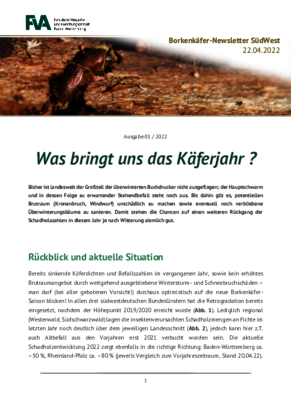
Bisher ist landesweit der Großteil der überwinterten Buchdrucker nicht ausgeflogen; der Hauptschwarm und in dessen Folge zu erwartender Stehendbefall steht noch aus. Bis dahin gilt es, potenziellen Brutraum (Kronenbruch, Windwurf) unschädlich zu machen sowie eventuell noch verbliebene Überwinterungsbäume zu sanieren. Damit stehen die Chancen auf einen weiteren Rückgang der Schadholzzahlen in diesem Jahr je nach Witterung ziemlich gut.
Die Buche macht weiter Sorgen - Waldschutzsituation 2021/2022 in Rheinland-Pfalz. Landwirtschaftliches Wochenblatt. Hessenbauer, Pfälzer Bauer, Der Landbote.Zum Artikel
Die Waldschutzsituation 2021/2022 in Rheinland-Pfalz und Saarland. AFZ/Der Wald 77 (9), 24-27
Management tactics to reduce bark beetle impacts in North America and Europe under altered forest and climatic conditions. In Gandhi, K.J.K., and R.W. Hofstetter, eds. Bark Beetle Management, Ecology, and Climate Change. New York: Elsevier. pp. 345-394
Management tactics to reduce bark beetle impacts in North America and Europe under altered forest and climatic conditions. In Gandhi, K.J.K., and R.W. Hofstetter, eds. Bark Beetle Management, Ecology, and Climate Change. New York: Elsevier. pp. 345-394Zum Artikel
Waldschutzsituation 2021/2022. Krankheiten und Schädlinge im Wald. Rheinische Bauerzeitung (RBZ), Wochenblatt für das nördliche Rheinland-Pfalz und Saarland 38, 29-32
Borkenkäfer an Nadelbäumen - erkennen, vorbeugen, bekämpfen. FNR, Gülzow-Prüzen, 54 S.https://mediathek.fnr.de/broschuren/borkenkafer-an-nadelbaumen-erkennen-vorbeugen-bekampfen.html
Borkenkäfer-Management unter Berücksichtigung des Vollernter-Einsatzes
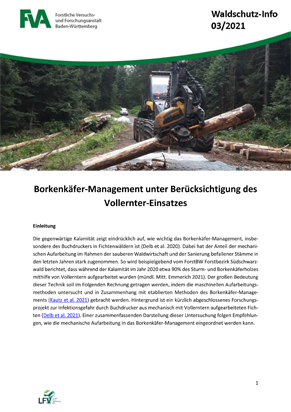
Die Aufarbeitung von Käferholz durch Vollernter nimmt immer mehr zu: Reduziert die Krafteinwirkung des Fällkopfs die Bruttauglichkeit der Borke und vernichtet vorhandene Käferbrut? Letztlich war unklar, ob die Stämme anschließend weiter behandelt werden müssen. Im Schwarzwald wurden dazu mehrere Untersuchungen durchgeführt.
Borkenkäfer-Monitoring in Baden-Württemberg. In: Waldzustandsbericht 2021 für Baden-Württemberg, 25-29
Borkenkäfer-Newsletter SüdWest 1/2021: Verzögerter Schwärmbeginn der Buchdrucker
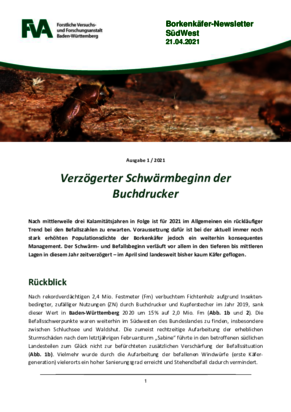
21.04.2021: Nach mittlerweile drei Kalamitätsjahren in Folge ist für 2021 im Allgemeinen ein rückläufiger Trend bei den Befallszahlen zu erwarten. Voraussetzung dafür ist bei der aktuell immer noch stark erhöhten Populationsdichte der Borkenkäfer jedoch ein weiterhin konsequentes Management. Der Schwärm- und Befallsbeginn verläuft vor allem in den tieferen bis mittleren Lagen in diesem Jahr zeitverzögert – im April sind landesweit bisher kaum Käfer geflogen.
Borkenkäfer-Newsletter SüdWest 2/2021: Auf zur Bohrmehlsuche!
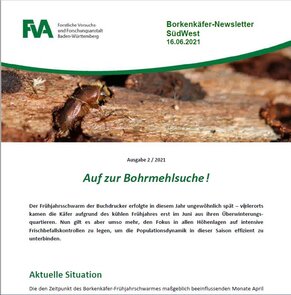
16.06.2021: Der Frühjahrsschwarm der Buchdrucker erfolgte in diesem Jahr ungewöhnlich spät – vielerorts kamen die Käfer aufgrund des kühlen Frühjahres erst im Juni aus ihren Überwinterungsquartieren. Nun gilt es aber umso mehr, den Fokus in allen Höhenlagen auf intensive Frischbefallskontrollen zu legen, um die Populationsdynamik in dieser Saison effizient zu unterbinden.
Borkenkäfer-Newsletter SüdWest 3/2021: Erste Generation fliegt aus
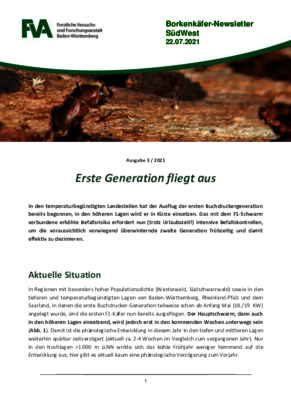
In den temperaturbegünstigten Landesteilen hat der Ausflug der ersten Buchdruckergeneration bereits begonnen, in den höheren Lagen wird er in Kürze einsetzen. Das mit dem F1-Schwarm verbundene erhöhte Befallsrisiko erfordert nun (trotz Urlaubszeit!) intensive Befallskontrollen, um die voraussichtlich vorwiegend überwinternde zweite Generation frühzeitig und damit effektiv zu dezimieren.
Borkenkäfer-Newsletter SüdWest 4/2021: Käferdichten und Befallszahlen vielerorts rückläufig
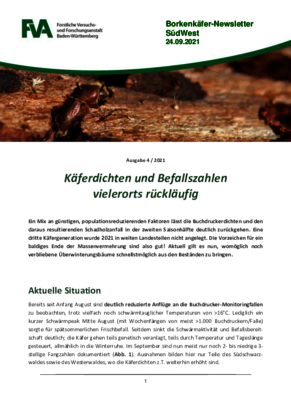
Ein Mix an günstigen, populationsreduzierenden Faktoren lässt die Buchdruckerdichten und den daraus resultierenden Schadholzanfall in der zweiten Saisonhälfte deutlich zurückgehen. Eine dritte Käfergeneration wurde 2021 in weiten Landesteilen nicht angelegt. Die Vorzeichen für ein baldiges Ende der Massenvermehrung sind also gut! Aktuell gilt es nun, womöglich noch verbliebene Überwinterungsbäume schnellstmöglich aus den Beständen zu bringen.
Borkenkäferkalamität bestimmt weiter das Handeln - Waldschutzsituation 2020/2021 in Rheinland-Pfalz und Saarland. Landwirtschaftliches Wochenblatt. Hessenbauer, Pfälzer Bauer, Der Landbote LW 20/2021, 21-23.
Die Waldschutzsituation 2020/2021 in Baden-Württemberg. AFZ/Der Wald 76 (9), 16-20
Die Waldschutzsituation 2020/2021 in Rheinland-Pfalz und Saarland. AFZ/Der Wald 76 (9), 26-29
Hackschnitzel-Versuch: Mortalitätsuntersuchungen an Borkenkäfern. Julius-Kühn-Archiv, 467, 368-369
Infektionsgefahr durch Buchdrucker (Ips typographus) aus mechanisch mit Vollerntern aufgearbeiteten Fichten - ein Beitrag zur Entscheidungsfindung in der Praxis - Forschungsbericht.
Infektionsgefahr durch Buchdrucker (Ips typographus) aus mechanisch mit Vollerntern aufgearbeiteten Fichten - ein Beitrag zur Entscheidungsfindung in der Praxis. Forschungsbericht FVA-Waldschutz, 31 S.
Infektionsgefahr durch Buchdrucker (Ips typographus) aus mechanisch mit Vollerntern aufgearbeiteten Fichten. Wald: Wie weiter? #ScienceForFuture, Forstwissenschaftliche Tagung 2021, Programm und Abstracts. Professur für Waldinventur und nachhaltige Nutzung, Technischen Universität München (Hrsg.), S. 345
Nadelbäume weiter stark gestresst. Badische Bauern Zeitung (BBZ) Nr. 24, 22-23
Schädlinge und Krankheiten im Wald. Rheinische Bauerzeitung, Wochenblatt für das nördliche Rheinland-Pfalz und Saarland, Nr. 40, 28-31
Schädlinge und Schäden an Laubbäumen. Badische Bauern Zeitung (BBZ) Nr. 21, S. 19
Themensammlung: Was bedeutet der Klimawandel für den Waldschutz; Online-Version, 10.05.2021
https://www.waldwissen.net/de/waldwirtschaft/schadensmanagement/insekten/themensammlung-schadinsekten-was-bedeutet-der-klimawandel-fuer-den-waldschutz
Borkenkäfer-Management bei hohen Käferdichten und Sturmschäden 2020. Waldschutz Info 1/2020, 11 S.
Die Borkenkäfersituation in Baden-Württemberg. Der Waldwirt 3, S. 12-14
In Erwartung der ?zweiten Welle?. Borkenkäfer-Newsletter SüdWest 02/2020, 6 S.
Modellierung von Borkenkäferphänologie und Befallsdruck. AFZ/Der Wald 18, S. 19-21
Sturmholz, hohe Käferdichte, warmer April: Die Zeit drängt! Borkenkäfer-Newsletter SüdWest 01/2020, 7 S.
Sturmschäden durch Orkan "Sabine" und Borkenkäfer im Wald? Eine hochexplosive Mischung; mit journalistischer Überarbeitung von Raiser, G.: Sabine und Borkenkäfer - explosive Mischung. Badische Bauern Zeitung (BBZ) Nr. 10 (2020), S. 24
Tree defence and bark beetles in a drying world: carbon partitioning, functioning and modelling. New Phytologist 225, 26-36
Witterung begünstigt Anlage der dritten Buchdrucker-Generation. Borkenkäfer-Newsletter SüdWest 03/2020, 5 S.
Inconsistent recognition of uncertainty in studies of climate change impacts on forests. Environmental Research Letters 14, e113003
Störungen im globalen Wandel In: WOHLGEMUTH, T.; JENTSCH, A.; SEIDL, R. (Hrsg.): Störungsökologie. UTB, Bd. 5018, Haupt, Bern, 325-336
Simulating the recent impacts of multiple biotic disturbances on forest carbon cycling across the United States. Global Change Biology 24 (5), 2079-2092
Die Waldschutzsituation 2021/2022 in Baden-Württemberg. AFZ/Der Wald 77 (9), 16-19
Forschung
- Populationsdynamik und Phänologie von Borkenkäfern
- Einfluss von Klimawandel auf biotische und abiotische Schadfaktoren
- Individuen- und prozessbasierte Modellierung, z.B. von Waldstörungen wie Borkenkäferbefall
- Methoden fernerkundlicher Schaderkennung
Monitoring
- Pheromonfallen- und Brutbaummonitoring von Borkenkäfern
- Phänologie- und Befallsrisikomodelle
Beratung
- Borkenkäferarten an Nadelbäumen
- Maßnahmen des Integrierten Borkenkäfermanagements
- Für alle Waldbesitzarten in Baden-Württemberg & Rheinland-Pfalz/Saarland
- Borkenkäfer-Pufferstreifen-Konzept im Nationalpark Schwarzwald
Lehrtätigkeit
keine Lehrtätigkeit vorhanden
